The Intel Haswell-E CPU Review: Core i7-5960X, i7-5930K and i7-5820K Tested
by Ian Cutress on August 29, 2014 12:00 PM ESTEvolution in Performance
The underlying architecture in Haswell-E is not anything new. Haswell desktop processors were first released in July 2013 to replace Ivy Bridge, and at the time we stated an expected 3-17% increase, especially in floating point heavy benchmarks. Users moving from Sandy Bridge should expect a ~20% increase all around, with Nehalem users in the 40% range. Due to the extreme systems only needing more cores, we could assume that the suggested recommendations for Haswell-E over IVB-E and the others were similar but we tested afresh for this review in order to test those assumptions.
For our test, we took our previous CPU review samples from as far back as Nehalem. This means the i7-990X, i7-3960X, i7-4960X and the Haswell-E i7-5960X.
Each of the processors were set to 3.2 GHz on all the cores, and set to four cores without HyperThreading enabled.
Memory was set to the CPU supported frequency at JEDEC settings, meaning that if there should Intel have significantly adjusted the performance between the memory controllers of these platforms, this would show as well. For detailed explanations of these tests, refer to our main results section in this review.
Average results show an average 17% jump from Nehalem to SNB-E, 7% for SNB-E to IVB-E, and a final 6% from IVB-E to Haswell-E. This makes for a 31% (rounded) overall stretch in three generations.
Web benchmarks have to struggle with the domain and HTML 5 offers some way to help use as many cores in the system as possible. The biggest jump was in SunSpider, although overall there is a 34% jump from Nehalem to Haswell-E here. This is split by 14% Nehalem to SNB-E, 6% SNB-E to IVB-E and 12% from IVB-E to Haswell-E.
Purchasing managers often look to the PCMark and SYSmark data to clarify decisions and the important number here is that Haswell-E took a 7% average jump in scores over Ivy Bridge-E. This translates to a 24% jump since Nehalem.
Some of the more common synthetic benchmarks in multithreaded mode showed an average 8% jump from Ivy Bridge-E, with a 29% jump overall. Nehalem to Sandy Bridge-E was a bigger single jump, giving 14% average.
In the single threaded tests, a smaller overall 23% improvement was seen from the i7-990X, with 6% in this final generation.
The take home message, if there was one, from these results is that:
Haswell-E has an 8% improvement in performance over Ivy Bridge-E clock for clock for pure CPU based workloads.
This also means an overall 13% jump from Sandy Bridge-E to Haswell-E.
From Nehalem, we have a total 28% raise in clock-for-clock performance.
Looking at gaming workloads, the difference shrinks. Unfortunately our Nehalem system decided to stop working while taking this data, but we can still see some generational improvements. First up, a GTX 770 at 1080p Max settings:
The only title that gets much improvement is F1 2013 which uses the EGO engine and is most amenable to better hardware under the hood. The rise in minimum frame rates is quite impressive.
For SLI performance:
All of our titles except Tomb Raider get at least a small improvement in our clock-for-clock testing with this time Bioshock also getting in on the action in both average and minimum frame rates.
If we were to go on clock-for-clock testing alone, these numbers do not particularly show a benefit from upgrading from a Sandy Bridge system, except in F1 2013. However our numbers later in the review for stock and overclocked speeds might change that.
Memory Latency and CPU Architecture
Haswell is a tock, meaning the second crack at 22nm. Anand went for a deep dive into the details previously, but in brief Haswell bought better branch prediction, two new execution ports and increased buffers to feed an increased parallel set of execution resources. Haswell adds support for AVX2 which includes an FMA operation to increase floating point performance. As a result, Intel doubled the L1 cache bandwidth. While TSX was part of the instruction set as well, this has since been disabled due to a fundamental silicon flaw and will not be fixed in this generation.
The increase in L3 cache sizes for the highest CPU comes from an increased core count, extending the lower latency portion of the L3 to larger data accesses. The move to DDR4 2133 C15 would seem to have latency benefits over previous DDR3-1866 and DDR3-1600 implementations as well.


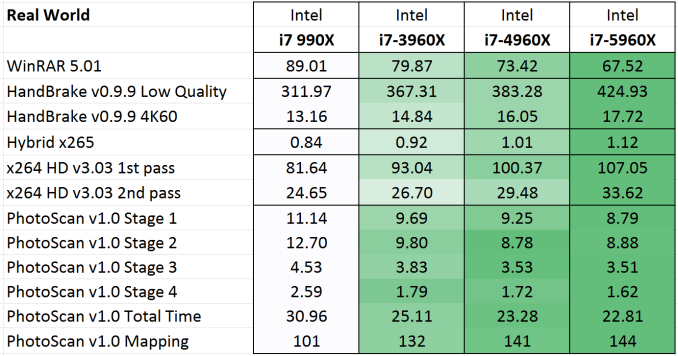


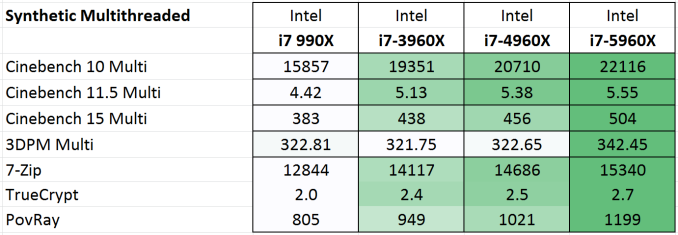

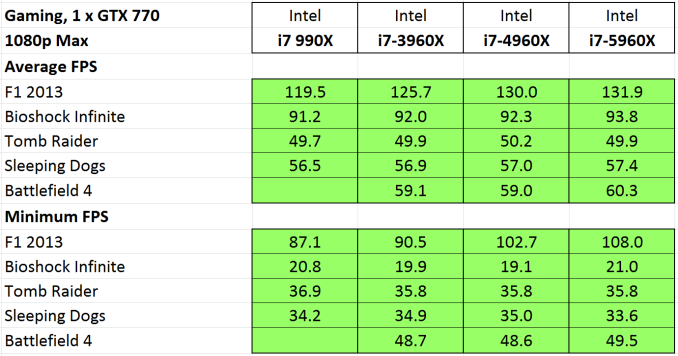
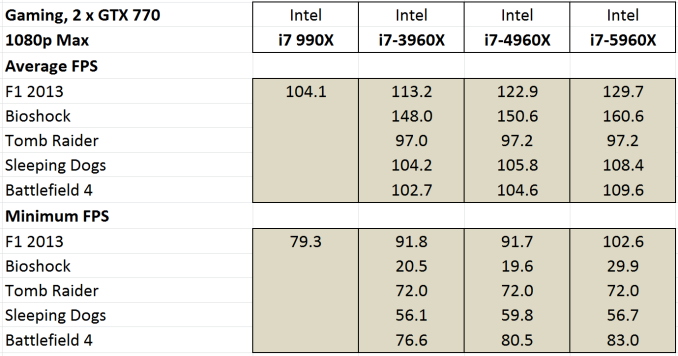
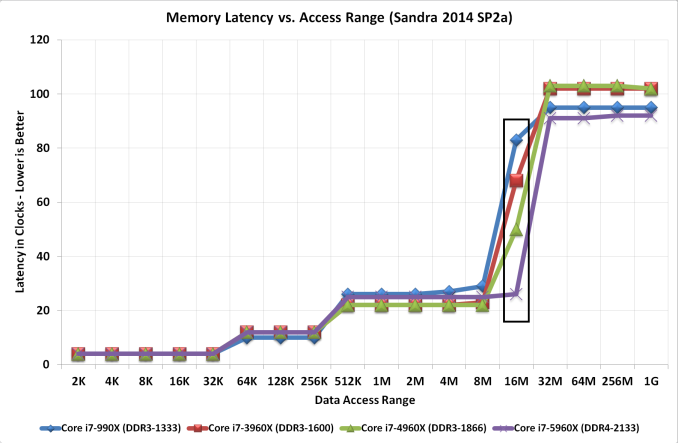








203 Comments
View All Comments
MrBungle123 - Friday, August 29, 2014 - link
Is there anything but 'edge case' justification for upgrading any more? PCs used to be exciting because things were always changing, this is just getting boring.edzieba - Friday, August 29, 2014 - link
VR. The frame rendering time requirements are pretty stringent. This is more on the GPU than the CPU for graphics, but you want to try and keep physics tics at a good rate to prevent objects jumping around the world.tech6 - Friday, August 29, 2014 - link
Even the 'edge case' is not longer a slam dunk as most workstation workloads like CAD do very well on the 4960X.The only real cases are heavy scientific number crunching, animation rendering and cracking password hashes by brute force.
MrBungle123 - Friday, August 29, 2014 - link
It used to be that if you were 2 generations behind your system was so slow and irrelevant that you just couldn't run modern software at anything approaching an acceptable level. Now we have a situation where ancient systems on X58 (circa 2008) are still close enough in performance to the extreme high end in 2014 to not only be in this review but also fit somewhere into the top half of the product stack of modern Haswell based hardware.If you compare a top of the line Nehalem chip to its equivalent from 6 years prior (a Northwood core P4 from 2002) it would make a mockery of 8 of them at the same time. This article is saying a 31% jump from Nehalem to Haswell-E -- that kind of performance increase (as a percentage) would have amounted to 2 or 3 months worth of clock speed bumps at any other time in the history of PCs.
wireframed - Friday, August 29, 2014 - link
Somewhat true, but consider that you get 30% IPC increase, 25-30% frequency increase and a 50% core-count increase, and it adds up to around a 100% increase in performance.Granted, 100-110% over 6 years is hardly impressive compared to earlier, but there isn't that much low-hanging fruit.
Also, the mainstream which drives revenue is, as you point out, largely content. They're looking at adding devices like tablets and consoles, instead of upgrading their computers. That probably plays into the amount of R&D Intel decides to spend on the HEDT platform.
Kain_niaK - Friday, August 29, 2014 - link
Exactly exactly exactly! I am still on X58 with a i7 990x. I don't play much games any more but even to play the newest games ... I do not need to upgrade my CPU and have not needed to upgrade my CPU since 2010. And even my i7 975x or a i7 920 from 2008 would still be more then fast enough. Then music. I use my system mainl as Digital Audio Workstation. Most of my plugins and music applications support multithreading. I cannot realistically ad so much stuff to a project that it maxes out the CPU. And rendering time? Who cares, most of my renders are done before I am done playing chess on the toilet anyway. Then overclocking. The i7 920 and anything on X58 was great. After that ... the fun and the excitement kind of went away and has never come back. What's the SUPERPI MOD record these days? I have not heard about any significant record breaking for a long time. Back in 2008, 2009,2010 I was hearing news about famous new overclock records. After that, it stopped. Let's face it. We hit a clock limit and for a breaktrought in singlethreated speed ... it's just not gonna happen until some genius designs a totally different system. Probably not using electricity but light. But that's like 20 years away because you don't just start over. All we have been doing is improving old technology not inventing something completely new. We are hitting the limits of nature ... so all the geeks and the nerds will just have to way at least another 10 years before we get to the exciting stuff again.MrBungle123 - Friday, August 29, 2014 - link
At this rate 10 years from now any Haswell i7 is still going to be within spitting distance of whatever the best is. lolIf you wan't Skylake performance today OC your Haswell by 250MHz, Ivy Bridge by 400MHz, or Sandy Bridge by 600MHz.
Laststop311 - Saturday, August 30, 2014 - link
it wont be the cpu performance difference that makes u upgrade it will be the new features. Skylake will have pci-e 4.0 and usb 3.1 and then chipsets after that will add more new things faster storage standards and who knows what else.I was already in this position. The speed of the i7-980x was still rly good. Got mine oc'd to 4261mhz. But guess what on x58 you get not pci-e3.0 no sata 3 no usb 3.0. These features have become very standard. You also get no sata express or pci-e ultra m2 which will soon be commonplace as well as no quad channel memory and no ddr4. All the missing features made me upgrade, not the speed. Similar situations in the future will cause people to upgrade every 4-6 years.
TiGr1982 - Tuesday, September 2, 2014 - link
You can still plug the PCIe USB 3.0 extension board there and get at least 2 USB 3.0 ports on the back of the case, to somewhat mitigate the age of the platform.But, with PCIe 2.0 and SATA 2, one is stuck, indeed.
actionjksn - Saturday, August 30, 2014 - link
Nehalm was great, but the last big bump was really Sandy Bridge. After that, not so much. This is actually a big concern for the processor makers. The technology and the silicon itself is reaching its limits as far as making significant gains on the next generations. They were getting big performance gains from just die shrinks alone, but those days are over. And how much more can they shrink them? It's getting harder all the time, they may get to 7nm to 10nm.